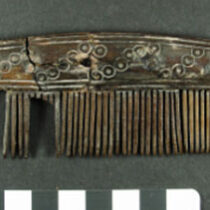Hedeby was the largest urban settlement in Viking-Age Scandinavia. Situated in modern Schleswig-Holstein, Germany, it is often considered Scandinavia’s gateway to continental Europe. Documentary sources suggest that it had links with northern Scandinavia, but few traded goods have survived in the archaeological record, and dating has proven difficult.
As part of the ArchSci2020 project (EU Horizon 2020), research student Mariana Muñoz-Rodriguez (supervised by Steve Ashby, and Lena Holmqvist from Stockholm University) sampled 49 antler hair combs from the site. They used comb form and decoration to target the earliest (9th-century) phases of the town. The samples were subjected to ZooMS analysis at BioArCH: a technique that allows the species of animal products to be rapidly identified, and which has proven very useful in the analysis of Viking combs from other sites.
The team found that 85-90% of the combs were made from reindeer antler, a species not locally available, confirming the existence of large-scale, frequent and consistent long-range maritime contact between Hedeby and more northerly parts of Scandinavia as early as AD 800.





